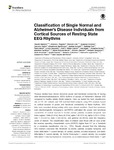Classification of single normal and Alzheimer's disease individuals from cortical sources of resting state EEG rhythms

Use este enlace para citar
http://hdl.handle.net/2183/16099Coleccións
- Investigación (FCS) [1295]
Metadatos
Mostrar o rexistro completo do ítemTítulo
Classification of single normal and Alzheimer's disease individuals from cortical sources of resting state EEG rhythmsAutor(es)
Data
2016-02-23Cita bibliográfica
Babiloni C, Triggiani AI, Lizio R, Cordone S, Tattoli G, Bevilacqua V, Soricelli A, Ferri R, Nobili F, Gesualdo L, Millán-Calenti JC, Buján A, Tortelli R, Cardinali V, Barulli MR, Giannini A, Spagnolo P, Armenise S, Buenza G, Scianatico G, Logroscino G, Frisoni GB, Del Percio C. Classification of single normal and Alzheimer's disease individuals from cortical sources of resting state EEG rhythms. Front Neurosci. 2016 Feb 23;10:47.
Resumo
[Abstract] Previous studies have shown abnormal power and functional connectivity of resting state electroencephalographic (EEG) rhythms in groups of Alzheimer's disease (AD) compared to healthy elderly (Nold) subjects. Here we tested the best classification rate of 120 AD patients and 100 matched Nold subjects using EEG markers based on cortical sources of power and functional connectivity of these rhythms. EEG data were recorded during resting state eyes-closed condition. Exact low-resolution brain electromagnetic tomography (eLORETA) estimated the power and functional connectivity of cortical sources in frontal, central, parietal, occipital, temporal, and limbic regions. Delta (2–4 Hz), theta (4–8 Hz), alpha 1 (8–10.5 Hz), alpha 2 (10.5–13 Hz), beta 1 (13–20 Hz), beta 2 (20–30 Hz), and gamma (30–40 Hz) were the frequency bands of interest. The classification rates of interest were those with an area under the receiver operating characteristic curve (AUROC) higher than 0.7 as a threshold for a moderate classification rate (i.e., 70%). Results showed that the following EEG markers overcame this threshold: (i) central, parietal, occipital, temporal, and limbic delta/alpha 1 current density; (ii) central, parietal, occipital temporal, and limbic delta/alpha 2 current density; (iii) frontal theta/alpha 1 current density; (iv) occipital delta/alpha 1 inter-hemispherical connectivity; (v) occipital-temporal theta/alpha 1 right and left intra-hemispherical connectivity; and (vi) parietal-limbic alpha 1 right intra-hemispherical connectivity. Occipital delta/alpha 1 current density showed the best classification rate (sensitivity of 73.3%, specificity of 78%, accuracy of 75.5%, and AUROC of 82%). These results suggest that EEG source markers can classify Nold and AD individuals with a moderate classification rate higher than 80%.
Palabras chave
Alzheimer's disease (AD)
Electroencephalography (EEG)
Exact low-resolution brain electromagnetic tomography (eLORETA)
Spectral coherence
Lagged linear connectivity
Area under the receiver operating characteristic curve (AUROC)
Delta rhythms
Alpha rhythms
Electroencephalography (EEG)
Exact low-resolution brain electromagnetic tomography (eLORETA)
Spectral coherence
Lagged linear connectivity
Area under the receiver operating characteristic curve (AUROC)
Delta rhythms
Alpha rhythms
Versión do editor
Dereitos
Creative Commons Licence Creative Commons Attribution 4.0 International License (CC-BY 4-0)






